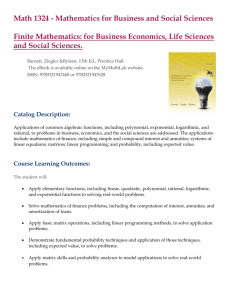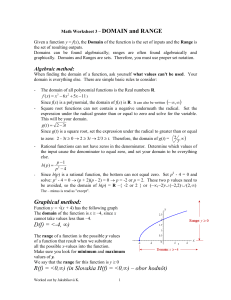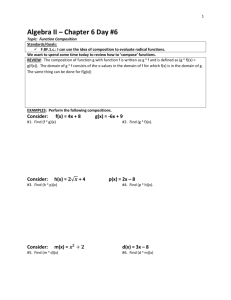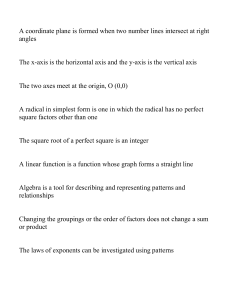Lesson Plan
advertisement
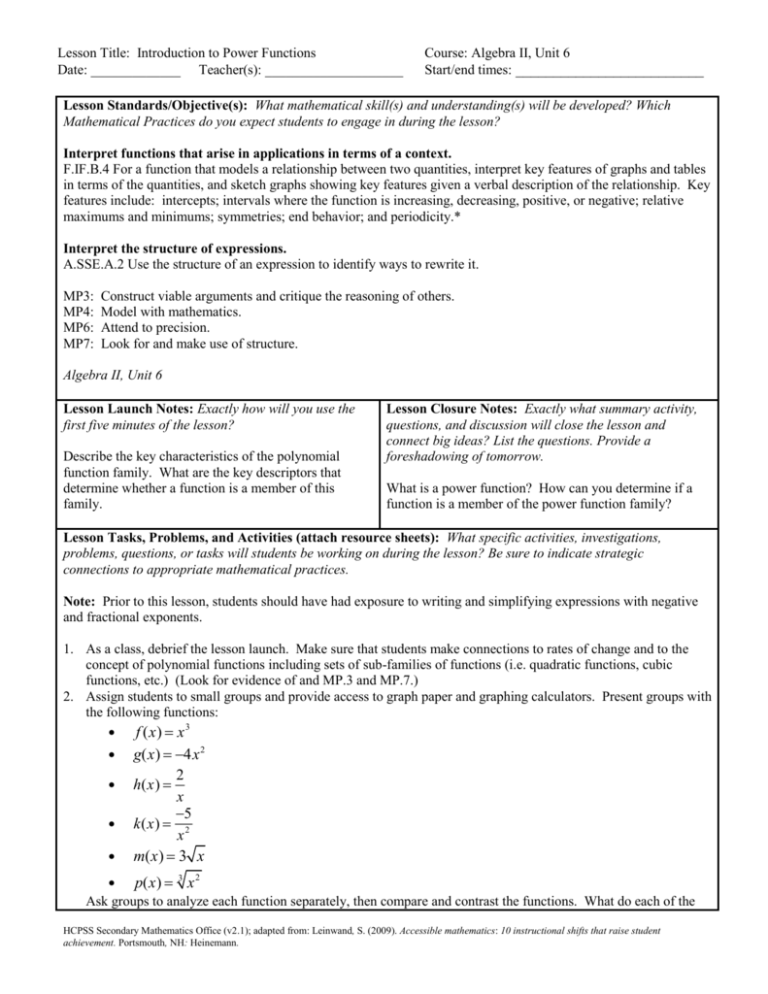
Lesson Title: Introduction to Power Functions Date: _____________ Teacher(s): ____________________ Course: Algebra II, Unit 6 Start/end times: _________________________ Lesson Standards/Objective(s): What mathematical skill(s) and understanding(s) will be developed? Which Mathematical Practices do you expect students to engage in during the lesson? Interpret functions that arise in applications in terms of a context. F.IF.B.4 For a function that models a relationship between two quantities, interpret key features of graphs and tables in terms of the quantities, and sketch graphs showing key features given a verbal description of the relationship. Key features include: intercepts; intervals where the function is increasing, decreasing, positive, or negative; relative maximums and minimums; symmetries; end behavior; and periodicity.* Interpret the structure of expressions. A.SSE.A.2 Use the structure of an expression to identify ways to rewrite it. MP3: MP4: MP6: MP7: Construct viable arguments and critique the reasoning of others. Model with mathematics. Attend to precision. Look for and make use of structure. Algebra II, Unit 6 Lesson Launch Notes: Exactly how will you use the first five minutes of the lesson? Describe the key characteristics of the polynomial function family. What are the key descriptors that determine whether a function is a member of this family. Lesson Closure Notes: Exactly what summary activity, questions, and discussion will close the lesson and connect big ideas? List the questions. Provide a foreshadowing of tomorrow. What is a power function? How can you determine if a function is a member of the power function family? Lesson Tasks, Problems, and Activities (attach resource sheets): What specific activities, investigations, problems, questions, or tasks will students be working on during the lesson? Be sure to indicate strategic connections to appropriate mathematical practices. Note: Prior to this lesson, students should have had exposure to writing and simplifying expressions with negative and fractional exponents. 1. As a class, debrief the lesson launch. Make sure that students make connections to rates of change and to the concept of polynomial functions including sets of sub-families of functions (i.e. quadratic functions, cubic functions, etc.) (Look for evidence of and MP.3 and MP.7.) 2. Assign students to small groups and provide access to graph paper and graphing calculators. Present groups with the following functions: f (x) = x 3 g(x) = -4x 2 2 h(x) = x -5 k(x) = 2 x m(x) = 3 x p(x) = 3 x 2 Ask groups to analyze each function separately, then compare and contrast the functions. What do each of the HCPSS Secondary Mathematics Office (v2.1); adapted from: Leinwand, S. (2009). Accessible mathematics: 10 instructional shifts that raise student achievement. Portsmouth, NH: Heinemann. Lesson Title: Introduction to Power Functions Course: Algebra II, Unit 6 Date: _____________ Teacher(s): ____________________ Start/end times: _________________________ functions have in common? How do the key features of their graphs compare? (Look for evidence of MP.3, MP.4, MP.6, and MP.7.) 3. Circulate as students work to monitor progress. Encourage students to sketch a quick graph of each function. Have students chart key ideas and post charts on wall. Have the class complete a gallery walk to review group ideas. 4. Lead a class discussion to highlight key ideas, which should include the following: Some functions are polynomial and some are not. (Students may or may not be able to recognize that some of the functions are radical and some are rational.) Some functions are continuous and some are not. The continuous functions all pass through the origin, while the discontinuous functions have a vertical asymptote at x = 0. 5. Ask, “Which of these functions are members of the same function family?” Have students share responses (most likely students will pair functions f & g, h & k, and m & p.) Say, “Would you be surprised if you learned that each of these functions are members of a function family? Why or why not?” Have students share their reactions. Tell students that these functions are in fact members of a special function family. Have students determine what criteria would be used to bind these functions to the same function family. Allow students to brainstorm conjectures in small groups, then share conjectures with the class. If all groups have not been able to determine the criteria, ask students to rewrite functions h, k, m, p using an equivalent expression. (Students should determine that each of the functions are of the form y = axn.) (Look for evidence of MP.3 and MP.7.) 6. Explain that this special function family is known as “power functions” and that this family includes subsets of many other function types (some polynomials, some radical, and some rational.) Emphasize that because all functions in this family are of the form y = axn, the function will either pass through the origin or have a vertical asymptote at x = 0. Also note that for some of the radical functions, the origin may be an endpoint for the function. 7. Have students generate a list of four additional power functions that are different (i.e. the examples should not all be polynomial.) For each function they identify, have them list the key features of the graph, including, domain, range, end behavior, and any asymptotes. (Look for evidence of MP.4, MP.6, and MP.7.) Extension Activity: Revisit the Ball Drop Task from Unit 1. Have students revisit the data gathered and justify why a power function is most appropriate for the experimental data. Evidence of Success: What exactly do I expect students to be able to do by the end of the lesson, and how will I measure student success? That is, deliberate consideration of what performances will convince you (and any outside observer) that your students have developed a deepened and conceptual understanding. Students will be able to identify key criteria for determining whether a function is a power function. Students will be able to generate a list of additional power functions and identify key features of the graphs. Success will be measured through observation of group work and through class discussions. Notes and Nuances: Vocabulary, connections, anticipated misconceptions (and how they will be addressed), etc. Vocabulary: power function Connections: Power functions are a special function family that connects members of the polynomial, rational, and radical function families. This lesson is designed to provide a bridge between earlier study of polynomial functions and the new rational and radical functions that students will explore in Unit 6. Power functions also may be viable options for modeling, particularly if the function model is a radical or inverse function. Resources: What materials or resources are essential for students to successfully complete the lesson tasks or activities? Homework: Exactly what follow-up homework tasks, problems, and/or exercises will be assigned upon the completion of the lesson? HCPSS Secondary Mathematics Office (v2.1); adapted from: Leinwand, S. (2009). Accessible mathematics: 10 instructional shifts that raise student achievement. Portsmouth, NH: Heinemann. Lesson Title: Introduction to Power Functions Course: Algebra II, Unit 6 Date: _____________ Teacher(s): ____________________ Start/end times: _________________________ Graph paper To be determined by teacher Graphing calculators Lesson Reflections: How do you know that you were effective? What questions, connected to the lesson standards/objectives and evidence of success, will you use to reflect on the effectiveness of this lesson? Are students able to make connections between power functions and other function families? How will students apply understanding of power functions to develop radical and rational function families? What changes do I need to make to tomorrow’s lesson based on my students’ current understanding? Howard County Public Schools Office of Secondary Mathematics Curricular Projects has licensed this product under a Creative Commons Attribution-NonCommercial-NoDerivs 3.0 Unported License. HCPSS Secondary Mathematics Office (v2.1); adapted from: Leinwand, S. (2009). Accessible mathematics: 10 instructional shifts that raise student achievement. Portsmouth, NH: Heinemann.
